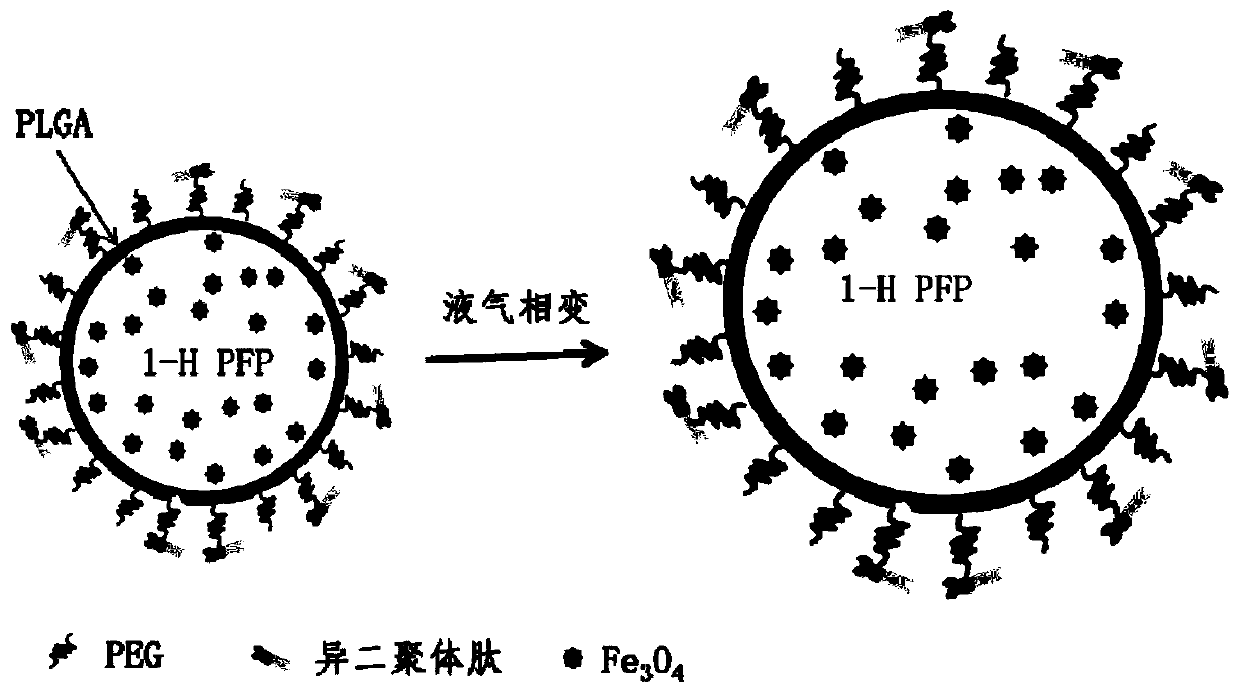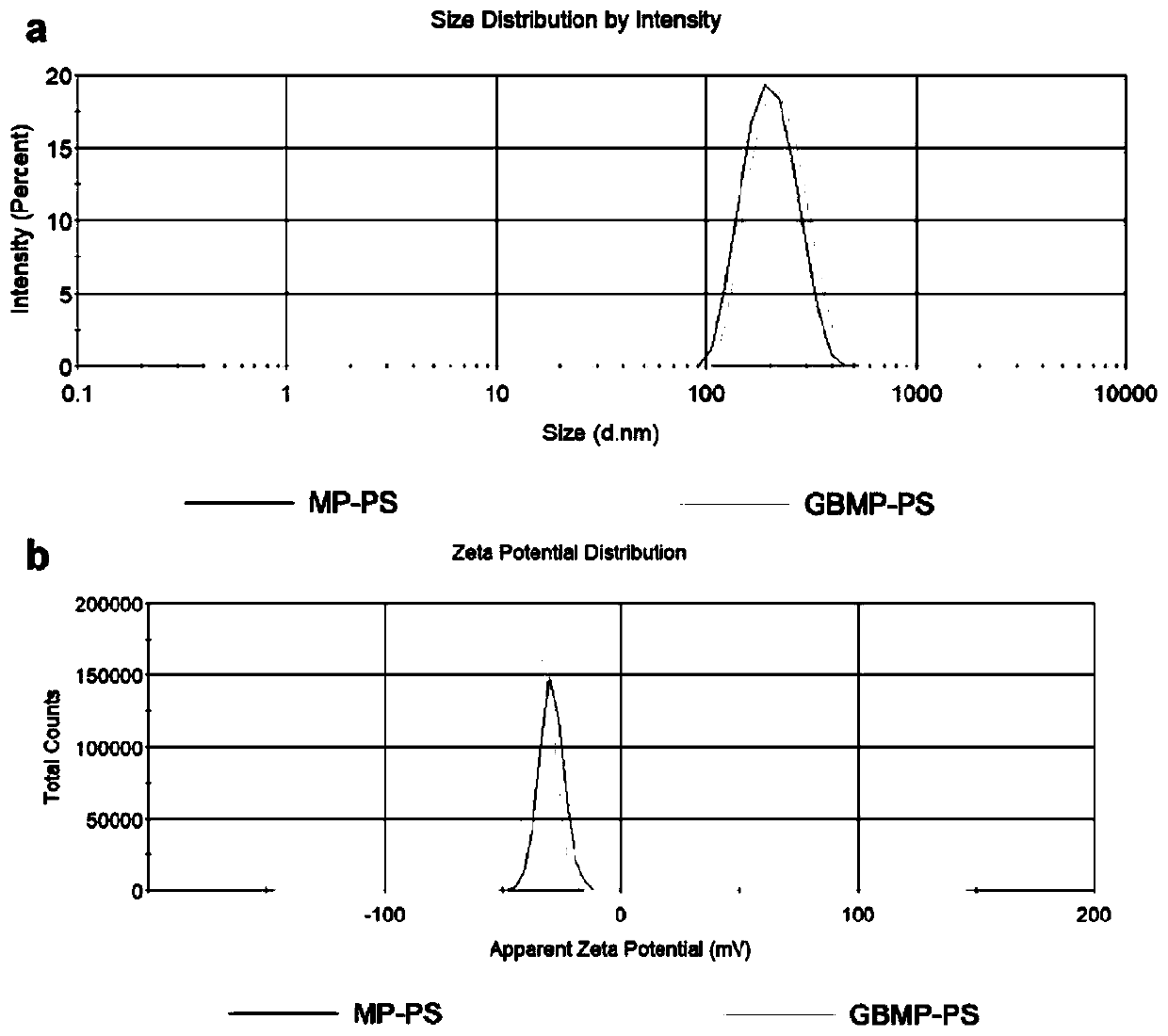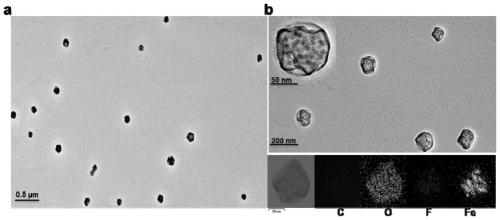Bispecific PSMA/GRPr targeted bimodal imaging nano contrast agent as well as preparation method and application thereof
A nano-contrast agent, bispecific technology, applied in the field of biomedicine, can solve problems such as poor effect of prostate cancer, and achieve the effect of enhancing active targeting effect, increasing hydrophilicity, and enhancing photothermal effect
- Summary
- Abstract
- Description
- Claims
- Application Information
AI Technical Summary
Problems solved by technology
Method used
Image
Examples
Embodiment 1
[0046] Example 1: Preparation of bispecific PSMA / GRPr targeted dual-modality imaging nanocontrast agent
[0047] A method for preparing a dual-mode imaging nano-contrast agent, the steps are as follows:
[0048] ① Accurately weigh 15mg PLGA-mPEG copolymer, 5mg PLGA-PEG-MAL copolymer, 4mg oleic acid modified Fe 3 o 4 Nanoparticles and pipette 40 uL of 1H-perfluoropentane dissolved in 1 mL of dichloromethane;
[0049] ② Add the above solution dropwise to the polyvinyl alcohol solution with a concentration of 4% by mass;
[0050] ③Use an ultrasonic cell pulverizer to emulsify the above mixture into balls under ice-water bath conditions;
[0051] ④Magnetically stir the mixture to fully volatilize the dichloromethane;
[0052] ⑤ The nanoparticles were centrifuged and washed 3 times, resuspended in ultrapure water and stored at 4°C. ,
[0053] ⑥ Disperse the nanoparticles obtained in the previous step into the PBS solution of PH=7.2, the material ratio of the nanoparticles to ...
Embodiment 2
[0062] Example 2: Safety assessment of bispecific PSMA / GRPr targeted dual-modality imaging nanocontrast agent
[0063] like Image 6 As shown, after incubating GBP-PS nanoparticles with prostate cancer C4-2 and PC3 cells for 24 hours, the cell viability remained above 90% even with an iron concentration as high as 200 μg / mL, which indicated the cytotoxicity of GBP-PS nanoparticles Low.
[0064] Get GBP-PS nanoemulsion 200ul to inject in the mouse body from tail vein (iron dosage 16mg kg -1 ), the tail vein of mice in the control group was injected with 200ul normal saline, and after 14 days of observation, blood was taken for whole blood analysis and blood biochemical detection, and HE staining was performed on the heart, liver, spleen, lung, and kidney. The results showed that each of the experimental group and the control group There was no significant difference in the blood test indexes and slices of various organs, indicating that GBP-PS nanoparticles have high safety i...
Embodiment 3
[0065] Example 3: Evaluation of cell targeting of bispecific PSMA / GRPr targeted dual modality imaging nanocontrast agents
[0066] After incubating GBP-PS nanoparticles with prostate cancer C4-2 (high expression of PSMA and low expression of GRPr) and PC3 (high expression of GRPr and low expression of PSMA) cells for 6 hours, confocal laser microscopy images showed that C4-2 ( Figure 7 a) and PC3 ( Figure 7 b) A large amount of FITC green fluorescence of GBP-PS is seen in the cytoplasm of the cells, indicating that the two types of cells have taken up a large amount of GBP-PS nanoparticles, and the PSMA antagonist 2-PMPA or the GRPr-binding peptide Bombesin can obviously competitively inhibit the corresponding Cells uptake it, while C4-2 and PC3 cells have only a small amount of uptake of nanoparticles without targeting peptide (FP-PS). The results demonstrated the specific targeting of GBP-PS nanoparticles to C4-2 and PC3 cells.
PUM
| Property | Measurement | Unit |
|---|---|---|
| particle size | aaaaa | aaaaa |
| electric potential / voltage | aaaaa | aaaaa |
| boiling point | aaaaa | aaaaa |
Abstract
Description
Claims
Application Information
 Login to View More
Login to View More - R&D
- Intellectual Property
- Life Sciences
- Materials
- Tech Scout
- Unparalleled Data Quality
- Higher Quality Content
- 60% Fewer Hallucinations
Browse by: Latest US Patents, China's latest patents, Technical Efficacy Thesaurus, Application Domain, Technology Topic, Popular Technical Reports.
© 2025 PatSnap. All rights reserved.Legal|Privacy policy|Modern Slavery Act Transparency Statement|Sitemap|About US| Contact US: help@patsnap.com



